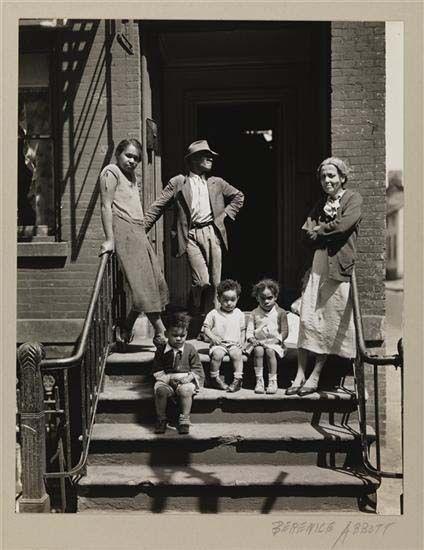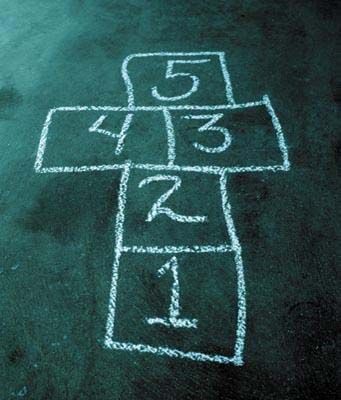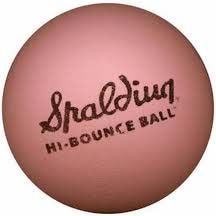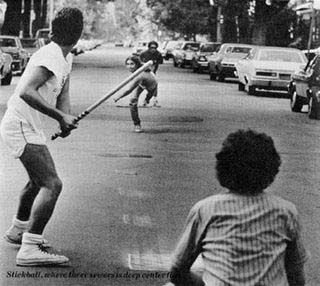
(Photo: Museum of the City of New York, Berenice Abbot)
(Cross-posted from Black Kos )
I was thinking today about growing up in NY (with part of each summer in Philly) and had memories of games I learned to play sitting on the stoop, or out on the sidewalk(or in the street dodging traffic)in Brooklyn, realizing that many of us share those same urban memories, though some are probably culturally specific. Others are generational – not sure how many kids still play simple games that don’t have a game controllers attached these days, but I can hope.
I remember hopscotch, skelly (or skully) played with bottle caps filled with tar, jonny-on the pony, ring-a-leevio, jacks and jump-rope. I had roller-skates that you tightened with a key. No roller rinks for us; we had cracked sidewalks.
I remember graduating from simple rope jumping to double dutch which became an art form and now has become a national competition. There was a “black girl” style to it which required timing and rhythm, whether you were turning the ropes or jumpin’ in – sometimes with more than one of your girlfriends.
Double Dutch
In African American Oral Traditions in Louisiana Mona Lisa Saloy discusses, playing the dozens, and other verbal forms of expression which start with simple rhyming and hand-clapping.
Verbal artistry among African American children is equally expressive and creative, although the forms are different. Children’s lore in New Orleans Black neighborhoods bears a necessary developmental function. Sidewalk songs pass on attitudes and knowledge of self, imitations of adult life and values, and distinct criticisms of adult life and societal norms.
She illustrates with this sidewalk rhyme:
I like ice cream
I like cake
I like a colored boy
And he don’t fake
So step back white boy
You don’t shine
I’ll get another colored boy
to beat yo’ behind
Last night,
the night before
I met my boyfriend at the candy store
He bought me ice cream
He bought me cake
He sent me home with a stomach ache
Mommie, Mommie, I feel sick
Call the doctor, quick, quick, quick
Doctor, Doctor, before I die
Close my eyes one to five
I said a one, a two, a three, a four, a five
See that house
On top of that hill
That’s where me and my boyfriend live
Cookin’ that chicken and cookin’ that rice
Come on baby, let’s shoot some dice!-Sunni Maria Fitch, age 6, with John Anthony Fitch, 4
New Orleans, 1987
I don’t remember anything quite that complex-what sticks in my head is “Miss Mary Mack”
Miss Mary Mack, Mack, Mack
All dressed in black, black, black
With silver buttons, buttons, buttons
All down her back, back, back.She asked her mother, mother, mother
For fifty cents, cents, cents
To see the elephant, elephant, elephant
Jump over the fence, fence, fence.He jumped so high, high, high
He reached the sky, sky, sky
He never came down, down, down
‘Til the 4th of July, ly, ly!
which crossed cultural groups-though I thought it was a black thing when I was a kid.
A great book about this is:
The Games Black Girls Play: Learning the Ropes from Double-Dutch to Hip-Hop
The Games Black Girls Play illustrates how black musical styles are incorporated into the earliest games African American girls learn-how, in effect, these games contain the DNA of black music. Drawing on interviews, recordings of handclapping games and cheers, and her own observation and memories of gameplaying, Kyra D. Gaunt argues that black girls’ games are connected to long traditions of African and African American musicmaking, and that they teach vital musical and social lessons that are carried into adulthood. In this celebration of playground poetry and childhood choreography, she uncovers the surprisingly rich contributions of girls’ play to black popular culture.
But as I said – it crosses cultures. Found an interesting subway video of hand-clap play
Some play was simply a matter of cooling off. Public swimming pools were rare, apartments not air-conditioned, so summer time was run under the pump time in many neighborhoods.
Equipment to play with was cheap. A clothes line rope, a “spauldeen ball” or a simple set of jacks.
I still remember chanting “A my name is Alice and my boyfriends name is Al …I come from Alabama and I eat apples,”as I bounced the ball under my leg.
The boys used the spauldeen to play stickball (as a tom boy I played too). You didn’t need fancy baseball equipment or a field. The street was where you played till it was too dark to see and your mom made you come inside.
The spauldeen was used in schoolyard handball. If you were really good you had a special old glove with the fingers cut off. Rarely did boys play with girls.
Sometimes I’d hea
d uptown on the subway to East Harlem (El Barrio) and the games were pretty much the same, with the addition of dominoes. You could hear the clicking on the outside card tables in front of tenement buildings and shouts of “capicu!” could be heard up and down the block. Everyone played, from the youngest kids to community elders.
I didn’t realize dominoes were part of African American history till I saw this painting by Horace Pippen:
As soon as you could hold a deck of cards you learned to play those games too. I started with tunk and spades but couldn’t wait to be old enough to play bid whist with my older cousins.
I never met anyone white who played bid whist, unless they grew up in a black neighborhood. By the time I was in college, whist playing was damn near a profession. I had classmates that flunked out of school cause they spent more time trying to “run a boston” than they did in their books.
Black artist Annie Lee documents bid whist in several of her pieces – notably
“6 no uptown”, meaning you were bidding no trumps with Ace king high…a very hard bid to make, and if you and your partner make it you have bragging rights for the night.
What games did you play growing up?









26 comments